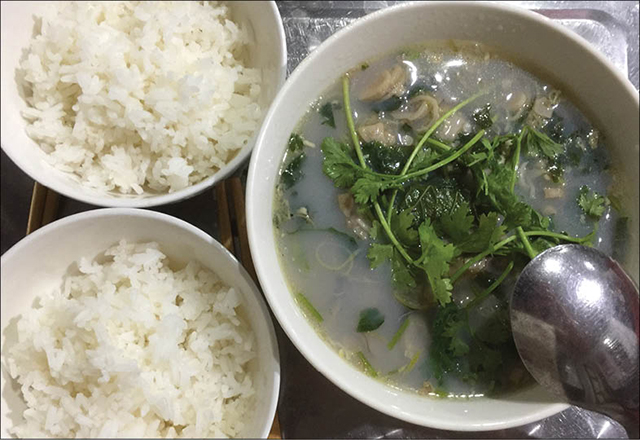
Banana flower soup with mussel - good soup for summer days
On those days, we went to school half a day only; on the other half, we took turn to tend buffalos. We liked summer best because we did not have to go to school. We followed our buffalos to the field, swimming in O Lau River catching mussels.
Plump, shiny yellow in color, as big as a big toe, mussels are a gift by the river which people living by Tam Giang Lagoon always cherish. With mussels, one can cook many good dishes as main courses or snacks such as mussel porridge, mussel soup with lemongrass, banana flower, or fermented bamboo shoot, fried with pineapple, etc., of which banana flower soup with mussel is “legendary” for men after drinking lots of wine.
Mussel is always my villagers’ top choice on summer days because it is wholesome and can be easily processed into many good dishes. In addition, mussels are easy to find. Just one or two hours in the river can bring back enough mussels for a good meal for a family of 5-6 people.
From my home, we children took our buffaloes toward Dua Boat Landing, crossed the field, then dived into the river for mussels. We were so familiar with the river and knew which areas were shallow.
Those who could not swim used toes skillfully to hold mussels when they stepped on them. Mussels were then put in a basket or a shirt tied at one end. Those who could dive well for a half day might collect enough for a small bag to bring back; smaller children, a shirt bag.
When fields have been flooded, and weeds removed, adults also join children catching mussels. Some families are more “professional.” After lunch, a family of 3-4 members went to the river to collect mussels for the market in the following morning.
Their tools were simple; just some washbasins and a pair of trieng giong (a pole and two rattan frames used to carry things.) At the time, mussels were pretty cheap; 5-6 tins cost only VND1.000. But in this way, some families could have extra income in their free season.
Mussels are no longer as abundant as before. People in my village are now better off and they do not have to dive in the river for mussels any more. Instead, they now can collect mussels in more “modern” ways and sell them for more money.
Mussels are sold now at about VND20.000-30.000/kg; but they are not always available. This kind is called sand mussels in my village. They are shiny yellow in color. The biggest one is only as big as a big toe, giving thick and sweet flesh. Boiled mussels give juice as white as milk. Be careful to distinguish mussels from clams from Tam Giang Lagoon seen in the market. Clams are bigger, blacker in color and gave thinner flesh.
Receiving some kilograms of mussels from my relatives in the village, I ask Mom to try to find a banana flower to make soup. Used to be for Daddy when he drank a lot of wine, now this becomes special food for my family in summer.
Many restaurants now include this soup in their menus. When diners are almost drunk, a bowl of banana flower soup with mussel will waken them immediately.
I was deep in thought about the past when Mom asked me to drain the mussels which she had soaked the night before. Clean mussels were then boiled in water on a medium fire. When the water got boiled, mussels opened up. I poured them into a basket and began to pick up the flesh. They were then washed again the last time.
Wait until mussel gets dry, then marinade it with some spices. Fry some beaten chives with some oil then pour in the mussel. Turn off the fire when you feel the good smell. As for the mussel juice, after decanted, boil it, then throw in banana flower which has been thinly sliced and soaked in water to remove the sap. Wait until the mixture get boiled again, then pour in the fried mussel. Sprinkle in some chopped spring onion and coriander to finish.
Banana flower soup with mussel can be eaten hot or cool without feeling the stink of mussel, with or without rice. I often eat it without rice. It is so delicious, especially on hot summer days.
Story and photo: Hong Tam